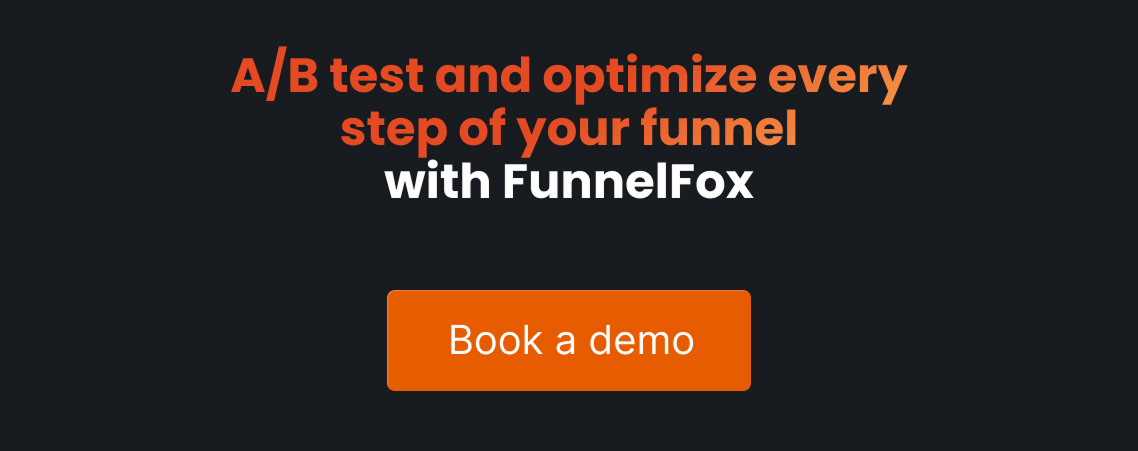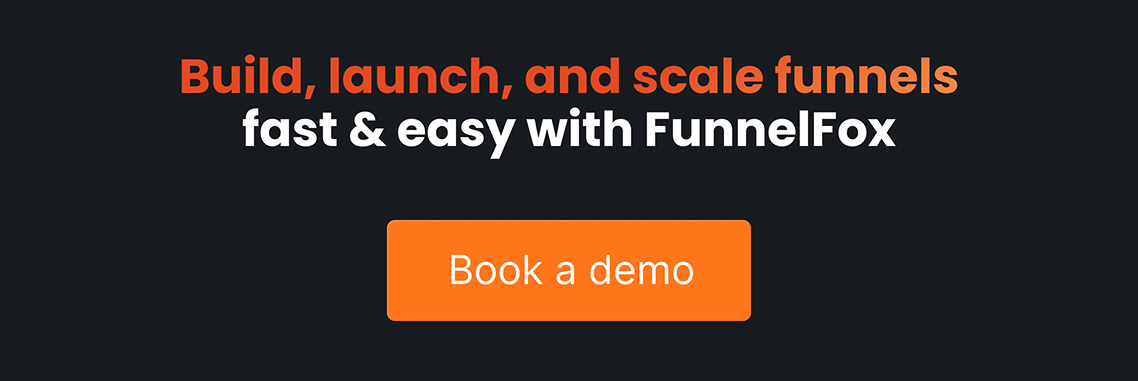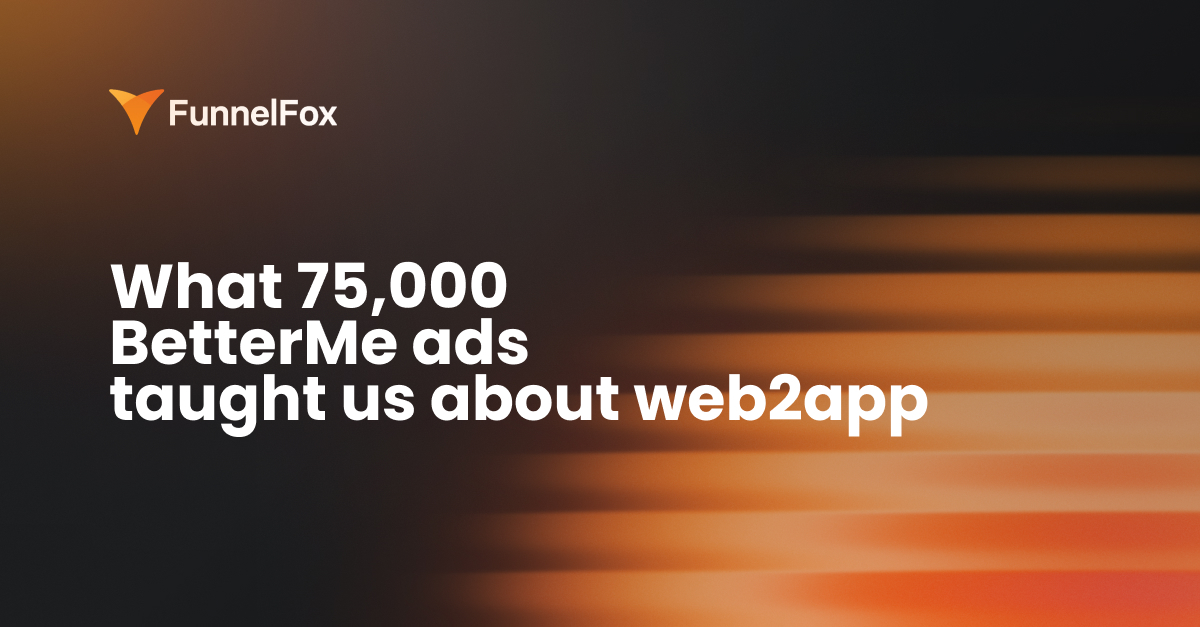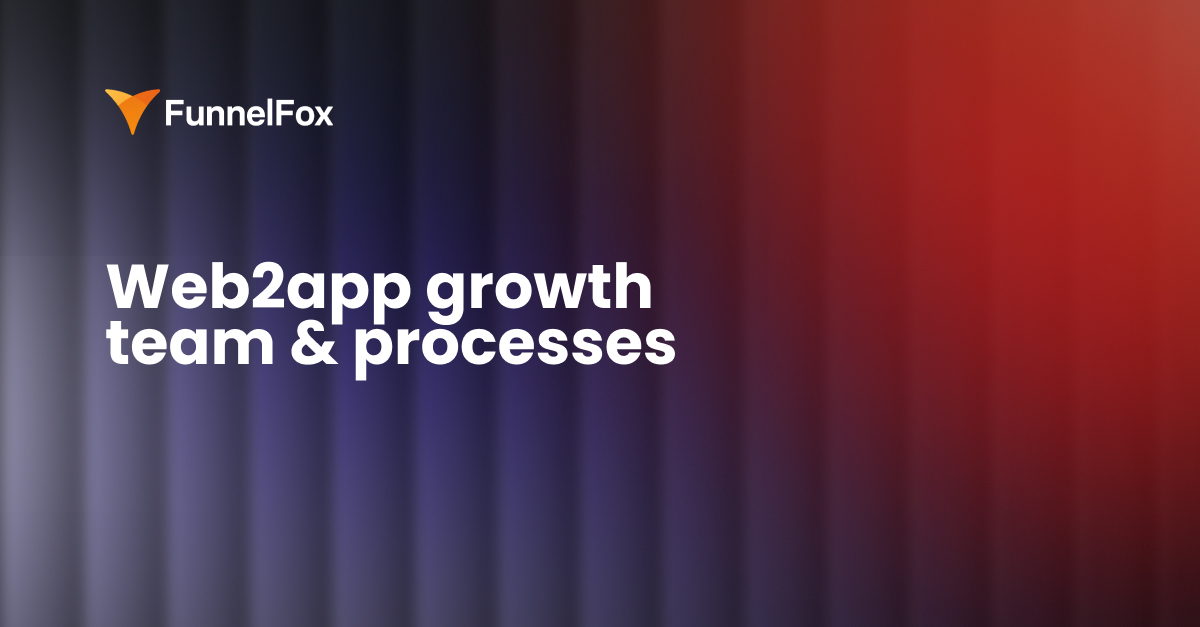Quiz funnels caught on fast when ecommerce brands realized people love two things: feeling seen and having fun. And what began as a simple engagement tool turned into a serious growth tool.
It didn’t stop at ecommerce. Quizzes spread into other industries, and mobile apps picked them up fast. Quiz funnels are now a go-to entry point in web2app funnels for mobile apps. Instead of sending cold traffic to a long landing page or straight to the App Store, you start with a short interactive quiz funnel that segments intent, shows value early, and moves users into an install, a trial, or a web checkout.
Top apps use quiz funnels to warm up intent, personalize the offer, and route buyers through web payments, so you keep attribution, speed, and more revenue without app-store friction.
In this article, you’ll learn why quiz funnels work so well, how to build one for your goals, pick up real tactics from top brands, and find out which elements to test and optimize to maximize your conversions.
What is a quiz funnel?
A quiz funnel is an interactive flow that asks users a few questions and gives them something personal in return, like a training plan or a recommended product.
In web2app funnels, quizzes are usually followed by a web checkout. But quizzes can also lead to a signup, a download, or another action.
A good quiz funnel does double duty: it captures leads and insights in one move. When done right, people don’t feel pushed or sold to. They feel understood and guided straight to the right solution.
Why quiz funnels work
It’s all about psychology
At the core, quizzes tap into powerful psychological triggers. Answering a few easy questions feels effortless, but it’s actually a micro-commitment, and once users start, they’re far more likely to finish.
Quizzes also create a sense of self-discovery, as users learn about themselves while answering the quiz funnel questions.
Format builds motivation and trust
A well-designed quiz funnel feels more like a game than a sales funnel. Progress bars, instant feedback, and relevant questions trigger motivation loops. And because users are actively involved, they’re more likely to trust the final recommendation.
Mobile UX makes quizzes a no-brainer
On mobile, attention spans are brutally short. Quiz funnels work because they break down information into quick, interactive steps. Instead of scrolling through endless landing page copy, users tap, swipe, and answer — an effortless and engaging flow.
Why do top apps build their growth strategies around quiz funnels?
Here’s what apps use quiz funnels for:
1. Warm up user intent. Quiz marketing funnels create a low-pressure entry point. Users engage through curiosity, not hard selling, and are more open to offers later in the funnel.
2. Improve CR and LTV. By asking smart questions upfront, apps learn what users want, what problems they’re solving, and how ready they are to buy — and personalize the offer accordingly. This unlocks better CR and cross-sell opportunities later.
3. Save on stores fees. Quiz funnels naturally lead users into web payment flows, helping apps bypass App Store and Google Play commissions and keep more revenue in-house.
4. Drive purchases by showing value from the first click. Plan preview, expected results, a before-and-after transformation — the faster users see what’s possible, the easier it is to move them forward.
In short, quiz funnels let you control the entire user journey, set expectations, and lead users into the purchase stage on your terms.
Real quiz funnel examples from leading apps
Let’s see how different brands use quizzes to engage users, personalize experiences, and drive conversions.
BetterMe uses quiz funnels as the first touchpoint in most of their web flows — from calisthenics to mental health to meal planning.
Each quiz grabs attention without being too pushy, making users feel guided, not forced. By the time they hit the app, they’re already mentally committed.

Noom, the weight-loss app, also uses detailed quiz funnels. They ask about weight goals, habits, challenges, and motivation levels, building a personalized plan before the install. This deep segmentation drives higher engagement, better retention, and stronger lifetime value.

Ladder, the fitness app, has built one of the cleanest quiz flows out there. They use a fast, lightweight quiz to match users with a personal workout plan based on fitness level, available equipment, and training goals. No landing page overload, no blind installs.

The quiz does all the heavy lifting in all these flows: builds trust, clarifies value, and pre-sells the experience long before leads see the paywall.
How to build a quiz funnel that engages and converts
1. Pick the right quiz funnel builder
You don’t need to reinvent the wheel — quiz funnel software like Typeform, involve.me, and others offer solid starting points.
But if you want to capture leads and convert them through web payments, FunnelFox was built for that. You can build your funnel using pre-tested, high-converting elements, plug in a paywall and checkout in just a few clicks, and go live fast. Your funnel won’t look generic — with flexible customization options, you can tailor the look to match your brand, all without writing a single line of code.
2. Hook users fast
Most people decide whether to stay or bounce in seconds. Your first screen must deliver instant recognition and curiosity.
- Tie the first message to the ad or email that brought them in. Same vibe, same promise.
- Keep it light: one strong question or visual hook is enough.

💡 To create a catchy page, you can use a proven screen formula like 4P (Pain–Promise–Proof–Push). Here’s what it can look like in a fitness funnel:
- Pain: “Tired of back pain and low energy?”
- Promise: “Our app can boost your flexibility and strength in just 10 minutes a day.”
- Proof: “Trusted by 500,000 users worldwide.”
- Push: “Take the quiz to get your custom workout plan.” </aside>
3. Understand their goals and context
Your quiz needs to feel relevant immediately. To do that, you have to ask the right questions—the ones that tap into users’ real goals, pain points, and motivations.
- Build your quiz funnel questions around user research: personas, JTBD, support logs, and real conversations.
- Make every question purposeful.
The more users feel “this is about me,” the deeper they’ll go.

4. Build trust as they move
Every interaction should increase confidence that your app can deliver real results.
- Sprinkle social proof (user numbers, reviews, awards) into your quiz funnel.
- Highlight credibility: “Backed by XYZ,” “Trusted by 1 M+ users,” etc.

5. Deliver personalized feedback
When users share information, they expect something back.
- Acknowledge their input immediately — even a simple “Got it!” keeps momentum.
- Show early, personalized feedback before asking for anything.
This makes users feel seen and creates a micro-reward that keeps them moving.
6. Preview the value
Don’t make users guess what’s coming. Give them a sneak peek.
- Show a plan preview, expected results, or a before/after transformation.
- Even a simple insight or “next steps” screen can double conversion to payment or install.

7. Personalize the final offer
Generic paywalls kill momentum. Your final CTA should feel tailor-made.
- Reference quiz answers in your offer.
- Use visuals (like “Your personal plan”) to make it tangible.
- Layer urgency lightly: “Offer reserved for the next 24 hours.”
When users feel the offer was “built for them,” they’re far more likely to say yes.

A/B test your quiz funnel to improve its performance
You can further refine your quiz funnels with A/B tests. Here’s what to test to get a significant improvement:
- First screen. Different headlines, CTAs, visuals. The first impression decides if users even bother with Screen 2.
- Storytelling style. Direct vs. aspirational tone. Long explanations vs. sharp one-liners. Social proof vs. product benefits. See which one builds more trust.
- Feedback loops. Instant responses to user answers: frequency, tone, and message. Even a small “You’re on track!” can boost engagement.
- Progress indicators. Use loaders, checkmarks, micro-goals. Real-time feedback keeps users moving.
- Positive friction. Adding lightweight steps like entering an email, choosing an avatar, or quick micro-surveys makes users more invested.
- Quiz length. Forget the myth that “shorter is better.” You need enough screens to deliver real value, whether it takes 5 or 15 steps. Still, it’s worth testing a faster quiz against a deeper, more immersive one to find the best balance for your users.
Pro tip: Before you call any test a success (or failure), validate your results through a statistical significance calculator. (Here’s a good one if you need it.)
💡 A/B test smarter with FunnelFox
FunnelFox gives you full A/B test analytics — so you can make faster, more confident decisions.
You’ll know exactly:
- Which variation is winning (with real confidence, not gut feeling)
- How big the difference is and if it’s worth scaling
- When to stop the test without wasting time or budget
- If you need more data or can trust the result now
No spreadsheets, no guesswork — just clear answers you can act on.

Why users drop off in quiz funnels (and how to fix it)
The ad did its job — users clicked and entered your quiz funnel. But most still don’t finish. Here’s what usually goes wrong and what to do about it.
Mistake #1: No match with the ad message
The ad promised something, but the first quiz screen feels generic or confusing. Users bounce before answering a single question.
Fix it:
- Make your quiz flow feel like a natural extension of the ad.
- Repeat the value you promised.
- Start soft: one question, one clear path forward.
Mistake #2: Generic, one-size-fits-all flow
Users answer questions, but nothing changes. No personalization, no sign that anyone’s paying attention. It feels pointless, and they leave.
Fix it:
- Ask pain-based, user-centered questions.
- Use branching logic to adjust the next steps based on answers.
- Make it feel like a real conversation, not a survey.
Mistake #3: No early value
Users give you data, but get nothing back. No insights, no previews, no payoff = no reason to keep going.
Fix it:
- Show personalized results early: a plan, a timeline, a glimpse of what’s coming.
- Visuals work better than promises — even a simple mockup makes a difference.
Mistake #4: Weak call-to-action
Even a strong quiz funnel can collapse if the final push is vague or hidden. If users have to think about what to do next, you lose them.
Fix it:
- One strong CTA tied to the quiz outcome.
- Clear, action-driven text (“Get My Plan”, “See My Results”).
- No clutter, no distractions.
Wrapping it up
Quiz funnels do what few other funnels can: engage users instantly, feel personal and fun, and drive conversions by sparking curiosity, not by hard selling. You’ll be surprised by just how far a great quiz can take your growth. Many top-performing apps owe a big part of their success to a strong quiz funnel strategy — just look at BetterMe whose entire growth strategy is wrapped around funnels. By running hundreds of quiz funnels across themes like pilates, yoga, and mental wellness, they’ve stayed one of the leading apps in the most competitive app category. And you can do it too — with FunnelFox.
You don’t need to build your quiz funnels from scratch or have a huge team behind you. With FunnelFox, you can launch your first high-converting funnel in minutes.
- Create custom screens or choose from our conversion-tested templates
- Add paywalls and checkout flows
- Pick and switch payment providers on the fly
- Run A/B tests with built-in analytics to get clear, confident results
Launch fast, test smarter, and optimize in real time, with no dev delays or app store approvals slowing you down.








